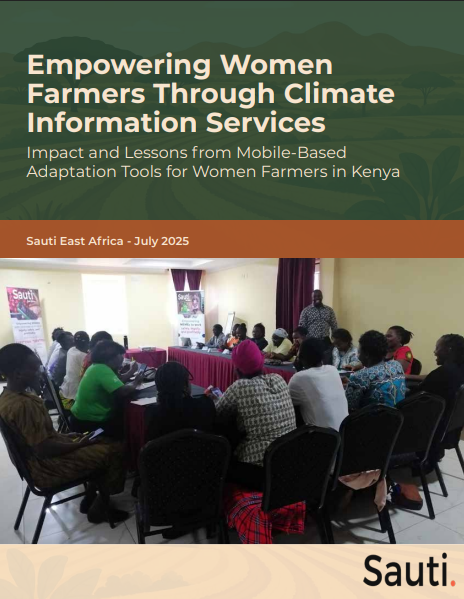Impact and Lessons from Mobile-Based Climate Tools for Women Farmers in Kenya
Kenyan women smallholder farmers play a vital role in national food security but are highly vulnerable to climate shocks and structural barriers like limited land rights and access to agricultural services. This report evaluates a mobile-based climate information service (CIS) initiative designed to close this gap. Implemented by Sauti East Africa with support from the International Climate Initiative (IKI), the program leveraged USSD, SMS, and WhatsApp platforms to deliver timely, accessible climate and agricultural information, tailored for low-literacy, low-connectivity environments.
The evaluation focuses on outcomes across four counties—Vihiga, Homa Bay, Uasin Gishu, and Busia—using both quantitative surveys and qualitative interviews to measure impacts on resilience, decision-making, market access, and digital engagement.
REPORT FINDINGS
Climate Preparedness Practices Increased: The average number of preparedness actions taken by women rose from 2.05 to 2.94 per respondent (p < 0.001). A total of 91.1% of participants reported using frequent weather monitoring, and 89.7% indicated they acted on early alerts. These figures suggest improved capacity for anticipatory planning and risk management.
Adoption of Climate Adaptation Strategies More Than Doubled: Women farmers adopted an average of 2.59 adaptation strategies at endline, compared to 1.35 at baseline (p < 0.001). The most frequently adopted practices included crop rotation or intercropping (9% to 46.4%), soil conservation measures (15.8% to 31%), and use of drought-resistant crop varieties (23% to 41.8%).
Improved Access to Climate and Agricultural Information: Use of USSD platforms increased from 23% to 69.3%, and SMS usage rose from 6% to 73.4%. These tools became key channels for accessing climate and agricultural content, particularly among women with basic mobile phones and limited digital literacy.
Mobile Phones Became the Primary Source of Climate-related Information: The proportion of women who preferred mobile phones as their main source of agricultural and climate information grew from 38% to 90%, surpassing traditional channels such as radio, television, and extension services.
Confidence and Decision-Making Improved: Self-reported confidence in accessing agricultural services increased from 3.46 to 3.83, and decision-making capacity rose from 3.67 to 3.94 (p < 0.001). Respondents reported greater ability to plan farming activities, select crops, and allocate resources based on information received through the platforms.
Incomes Rose in Parallel With Market Access: Average monthly income from farming activities increased from KES 10,286 to KES 12,338. The proportion of women who identified new buyers rose from 43.3% to 54.7%, indicating improved market engagement supported by digital tools.
Digital Market Engagement Increased: Use of WhatsApp to identify buyers increased from 11.0% to 22.9%, while USSD use for trade purposes rose from 1.0% to 5.4%. These platforms supported direct communication with buyers and provided access to price information and market trends.
Sourcing of Inputs Leaned Toward Online Platforms: The proportion of women using online platforms to find agricultural suppliers rose from 4.3% to 11.8%, while WhatsApp use for sourcing inputs increased from 1.5% to 9.5%. Mobile platforms enabled farmers to compare prices, locate suppliers, and share information within peer groups.
REPORT RECOMMENDATIONS
- Scale Low-Tech Digital Channels: Expand USSD, SMS, and IVR to support users without smartphones or internet access.
- Build Digital Confidence Through Peer Learning: Strengthen women’s digital literacy via refresher trainings and WhatsApp-based mentoring.
- Co-Design Localized Content With Women Farmers: Ensure platforms reflect regional dialects, farming needs, and seasonal trends.
- Improve Market Linkages Through Mobile Tools: Offer price alerts, transport advice, and buyer directories to boost trade readiness.
- Institutionalize CIS in Government Extension Systems: Integrate mobile tools into county-level extension services and coordinate with telecom providers to reduce access barriers.
